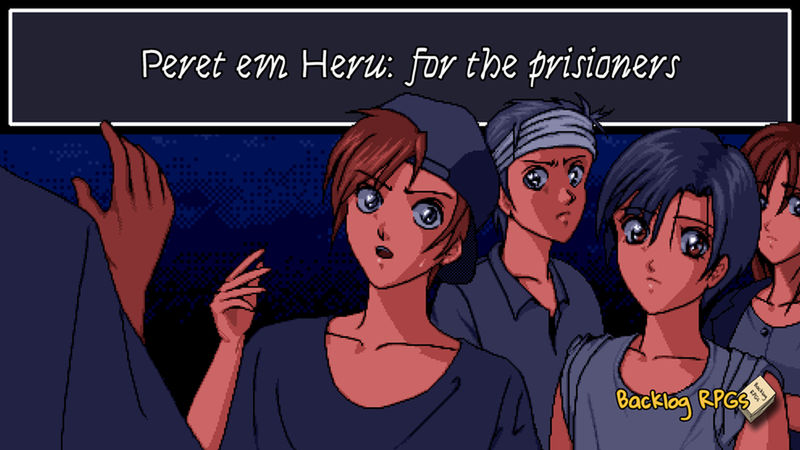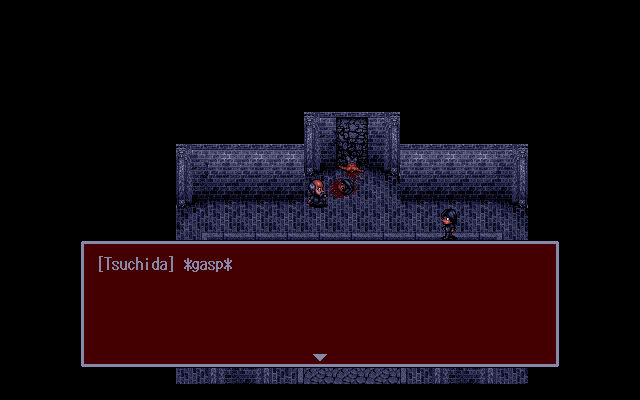Here’s a short review for a fun little game. Peret em Heru: for the prisoners (or Shūjin e no Pert-em-Hru 囚人へのペル・エム・フル) is an independent game released on May 31, 1998. It was developed on RPG Maker 98 Dante II by Makoto Yaotani, under the pseudonym Makoto Serise, with music composed by Kei Mizuho. According to Wikipedia, it won the Platinum Award for the August rendition of the “Internet Contest Park”, held by ASCII on a monthly basis from July 1998 to June 2002.
On September 26, 2014, the fan translation group Memories of Fear released an English translation for the game. You can download both on their website.
The Narrative

The game starts with the discovery of subterranean structures on the Great Pyramid of Giza, tomb of pharaoh Khufu, by Professor Tsuchida and his assistant, Koji Kuroe. The men try to open the door of the hidden chambers but are unable to move it. They ask the help of a hired miner, who starts to push the door. As he was almost opening it a trap decapitates him, leaving both survivors astonished.
Not desiring to wait and lose his finding, the Professor starts to ponder on what to do if there are more traps along the way> He thinks of a wicked plan: use some tourists as human shields. As he goes back to the entrance of the pyramid, he encounters a group of Japanese visitors and invites them to help on his groundbreaking excavation.
The group is composed of high school students Ayuto Asaki (our main character), Kyosuke Hino, Nei Ichikawa and Yoko Nogisaka (sometimes called Yoyo, a funny typo), the problem child Rin Tsukihara, wanna be Snorlax Mitsuru Koeiji, another high school student named Saori Shinoda, the tourist guide Sae Otogi and the reporter Soji Mizumi.
The group than heads to the subterranean entrance to uncover the secrets of pharaoh Khufu’s tomb.
You start the game with 11 characters. As the story progresses, some will die after being judged by the mystical powers inside the pyramid. Deaths are brutal with some cool pixel gore, and affect the story’s outcome in some well thought ways. But if you’re able to save your companions, you will see a happier ending.
For a short game, there is a lot going on. You will find drug trafficking, a serial rapist, a love square (there are four people involved), greed, and jealousy. The further the group explore the pyramid, the more you will know about them. Some are sympathetic, others are just terrible human beings. Ultimately, as their past sins are revealed, they will be judged. If they survive the endeavor, some characters will try to find atonement for their past actions, thinking on improving themselves going forward.
Even if the plot is a tad formulaic, I enjoyed knowing more about each character’s true self. The game surely goes beyond the themes you would normally see on commercial titles of the time, so congratulations to the developers.
Presentation
After starting the game, my first impression is that I was playing something on a PC-98 or a PC Engine/Turbografx-16. Graphics are what you expect from an RPG Maker game of the time, however the artwork for characters, enemies and for a some secenes brings some personality to the title. The few songs available are fine, but nothing that you will be listening after finishing your playthrough.
Mechanics
Since Peret em Heru was made on the RPG Maker engine, it behaves like a traditional JRPG, packed with random encounters and turn-based fights. But the game’s creators, inspired by the original Corpse Party, decided to implement puzzle solving to spice things up.
Characters’ deaths work as little puzzles which you must solve to save your companions. Failing to perform the right actions or use the appropriate item will result in their demise. It’s a mechanic reminiscent of adventure games that gives more depth and personality to what would be a run-of-the-mill JRPG.
But be aware, some deaths happen so seamlessly that you will only know about it when one of your companions point out someone is missing. So save scum with care!
To see how many characters are alive just go to the menu.
Choosing which companions to save is important since it reflects on who can be recruited to your active party. On that aspect, besides the main character, you can only pick one more person to explore the pyramid. Most characters can only be recruited after they survive the pharaoh’s judgment. This limitation adds a little layer of strategy during the play through.
As for battles, they are your standard JRPG fare. Attack, heal and use special abilities until enemies are dead. There is no deeper thought involved, just brute force them.
Final Thoughts
I enjoyed this little game. It has a contemporary setting, a good story with some heavy themes and characters that are very interesting. Unfortunately, besides the puzzles the gameplay doesn’t offer anything out of the ordinary. But that shouldn’t be a problem thanks to the game’s short length.
I think it’s a very good game, even more if you don’t want to commit to something longer or just need a quick RPG fix.
For those who enjoyed this little game, apparently there is a remake in the works. You can see more here.
Final opinion: Recommend for its length, fun puzzles, good story and interesting characters. It’s also free.







